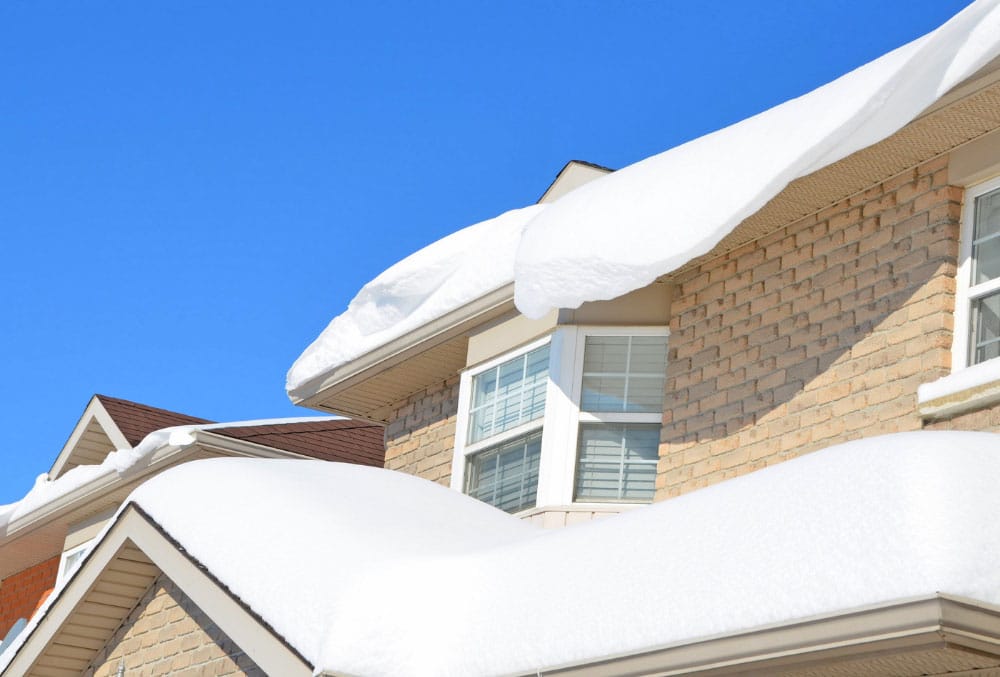How Much Snow Is Too Much For Your Roof?
December, 29 2021″
How to Manage Snow Accumulation on Your Roof This Winter
As the winter season kicks off and snow begins to fall, many homeowners are concerned about the risks of snow accumulation on the roof. Winter roof maintenance is essential to keep your roof in decent condition all year. Roofs can collapse from snow and ice, especially older structures facing extreme weather conditions.
Newer structures with lightweight metal roofs, flat roofs, or roofs with few supports are more susceptible to cave in under the weight of excessive snow and ice. Corrosion is also possible in older homes, compromising structural stability. Home Insurance in Ontario helps protect homeowners from the financial impacts of unexpected weather-related accidents.
Regardless of where the property is located, most residential roofs should withstand 20 pounds per square foot of snow before being strained.
Snow removal from your roof is a dangerous task. Instead of risking a hazardous fall from ice overhangs or mounting a ladder in the cold, we will explain how to manage snowfall safely and efficiently.
Snowfall Impacts Every Roof Differently
Several considerations help determine the best course of action when it comes to preparing your roof for snowy weather. Your roof’s design, construction materials, and roofline are some factors that come into play.
These considerations impact your roof’s ability to withstand snowfall in different ways:
- Roof Design – A steep roof typically sheds snow easier than a flat roof.
- Type of Snow – The density of the snow affects its weight. Generally, light and fluffy snowfalls are less problematic than dense wet snow.
- Shingle Material – Your roof quality and the durability of the shingles determines how well your roof can support the weight of snow.
You can ensure that your roof withstands incoming snow and ice better by checking it now and repairing any damage or issues before winter arrives. Keep ice off sloped roofs and slow down ice development on the roof by ensuring attics are sufficiently ventilated. That way, snow is less likely to melt and refreeze as ice.
When an attic isn’t adequately ventilated, heated air from the house rises, causing melting, freezing, and hazardous ice dams.
When ice dams form, melted snow and ice can enter a roof through crevices, preventing water from flowing into roof drains. Gutters may also fill with snow that can melt and then refreeze into ice, weighing down the eaves and causing issues if the weight load becomes too great.
Preventative maintenance is critical during the winter months to avoid costly repairs. The weight collected on the roof is one of the most extreme snow and ice accumulation risks.
Evaluating Your Roof For Potential Problems
While looking at your roof from the street may provide some clues, the most valuable indicators of a potential problem may be located within.
- Inspect the attic rafters for apparent bending or cracks
- Check for termite damage in the rafters
- Address damage from the previous winter
- On upper floors, in the center of the house, keep an eye out for new fractures in the drywall or plaster surrounding internal door frames
- If your doors suddenly become stuck when they used to open and shut effortlessly, it might be a clue that your home has altered due to a structural issue
If you find an issue during your inspection, contact a certified structural engineer as soon as possible to analyze the problem. Wall cracks and squeaky doors don’t necessarily indicate severe issues, but they are reasons to seek the help of a competent specialist.
Preparing Your Roof Before Snow Season Begins
Melting snow tends to flow down steep sloping roofs with slopes more than 3 inches in 12 inches of horizontal space more quickly, especially the steeper ones seen on buildings in northern regions.
During severe winds, ice and snow tend to gather more quickly on low slopes and flat roofs over porches or areas of a residence near a higher piece of the house.
If you reside in an icy region, check with your local construction authorities to see if larger loads were utilized when your house was constructed.
Although most roofs should support up to 20 pounds per square foot of snow, older structures and homes with flat roofs may struggle to support even small snow accumulation. Dry snow weighs roughly 5 pounds per foot, but wet snow can weigh over 20 pounds.
Calculating How Much Snow Your Roof Can Hold
You can estimate how much the snow on your roof weighs depending on the type of snowfall. These guidelines can help you determine if the snow on your roof is endangering your home’s structure or not.
- Fresh Snow – One foot of fresh snow weighs about the same as one inch of water or five pounds per square foot.
- Packed Snow – One foot of packed snow weighs approximately 12 pounds per square foot.
- Ice – One inch of ice on your roof is the equivalent of one foot of fresh.
The IIBHS or Insurance Institute for Business and Home Safety provides general guidelines for homeowners to determine excessive snow for a roof. Over four feet of fresh snow, two feet of packed snow, or one inch of ice could cause concern.
In this case, it may be time to consider safely removing the snow from your roof.
You can calculate the specific snow load on your roof using the snow load calculator.
When and How to Remove Snow From Your Roof
Removing snow from your roof is unnecessary after every snowfall, and a thin layer of snow can be beneficial. Having a couple of inches of snow on your roof can act as insulation and keep your home warmer. Another reason is to avoid unnecessary damage to your roof shingles.
When the snow on your roof exceeds 20 to 25 pounds per square foot, you should consider removing snow from your roof based on the thickness of various types of snow and ice. Removing the snow by yourself can be extremely risky and should be avoided. Instead, hire a professional with the right tools to safely remove the snow for you.
If you decide to remove snow from your roof by yourself, remember to leave a thin layer of snow on the shingles. Any accidental damage to the shingles could cause a crack and eventual leaking.
Attempting to remove ice from gutters with a shovel could cause additional damage. Chemical de-icers can remove ice from gutters effectively, but you should avoid rock salts since they can damage your roof.
How Duliban Homeowners Insurance Protects You
Duliban Home Insurance in Ontario helps protect your home and belongings from the financial impacts of unexpected losses. Homeowners with an all-risk Home Insurance policy can rest easy this winter knowing that our coverage can help pay for snow-related roof damage.
Coverage protects policyholders from many winter weather risks with financial protection for the structure of your home and your possessions inside.
Your Home Insurance policy, combined with the proper preventative measures, will keep your roof in top condition for years to come. Find out what snow and ice damage is covered and not covered in your Homeowner’s coverage by checking for an Above Ground Water endorsement.
Speak to your Duliban Insurance agent today at (905) 892-5723 to review your current Homeowner’s policy or discover your options for coverage.
Sources:












